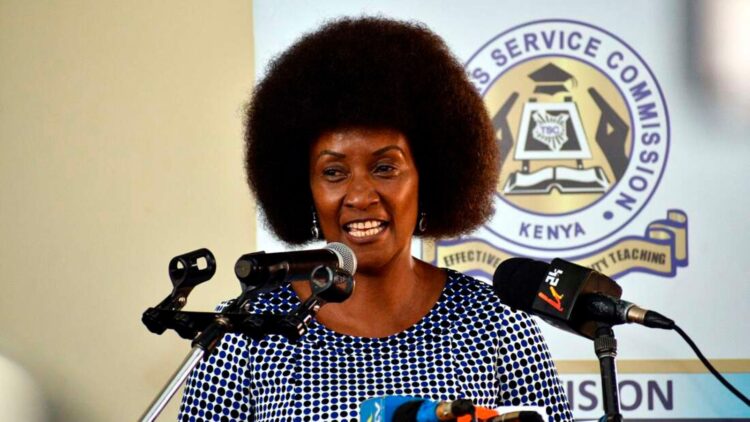Inside TSC’s Internship Push to Plug the 98,000-Teacher Deficit
As Kenya’s public education system struggles under the weight of a staggering 98,000-teacher shortfall, the Teachers Service Commission (TSC) has turned to an increasingly relied-upon solution—teaching internships.
Designed to bridge the widening gap between rising student enrolment and inadequate staffing levels, the internship programme offers temporary relief to overstretched schools while giving thousands of unemployed, qualified teachers a foothold into the profession.
Since its launch in 2019, the initiative has placed over 94,000 interns in classrooms nationwide, positioning it as a key pillar in the government’s strategy to sustain learning in the face of constrained budgets and overwhelming demand.
According to the Economic Survey 2025, enrolment across all school levels continues to rise. Pre-primary enrolment grew to 2.91 million in 2024 from 2.88 million in 2023. Primary and junior school numbers increased by 3.2% to 10.73 million, while secondary school enrolment jumped 5.2% to 4.32 million.
In contrast, the number of teachers in public primary schools declined by 3.2% to 212,602, while those in secondary schools and training colleges rose from 125,563 in 2023 to 130,818 in 2024.
TSC CEO Nancy Macharia informed Parliament that Kenya faces a deficit of 98,261 teachers, a number expected to increase with the introduction of senior schools in 2026. “Currently, the teacher shortage stands at 98,261, including junior school teachers.
This number is anticipated to rise in 2026 following the roll out of senior schools,” she said. Macharia added that TSC has never reached its ideal staffing level since inception, and this underlines the need for enhanced budgetary allocations.
Macharia also addressed the rising concerns over political interference in the hiring process. She denied claims that Members of Parliament were distributing TSC appointment letters, saying the commission remains the sole authority in teacher recruitment.
TSC’s Recruitment Challenges and Criteria
The CS reiterated that the hiring of teachers depends on funding and the availability of slots within authorised staffing limits. “The recruitment of teachers across the country is premised on several factors, including the availability of funds and the existence of vacancies in authorised establishments,” he explained.
He also mentioned that the TSC prioritises candidates who have remained unemployed the longest, particularly those who completed training as early as 2017. The aim is to reduce long-term joblessness and ensure fairness during the recruitment process.
To address regional staffing disparities, Ogamba noted that the TSC consistently assesses school staffing levels and advises the Ministry of Education on subject and area-specific shortages. He explained that the recruitment process also factors in curriculum changes and strives to ensure balanced deployment across the country.
In October 2024, TSC advertised 46,000 teaching vacancies and received 314,117 applications between October 1 and 8. Of these, 93,646 applied for 6,000 primary school positions, and 144,177 applied for 39,550 junior secondary posts. The commission also received 76,294 applications for just 450 secondary school positions.
One applicant told Teachersupdates.news, “I have applied for every recruitment cycle since 2018 with no success. It’s disheartening to wait endlessly.” Another added, “We feel ignored and helpless. The government needs to prioritise those of us who’ve waited for years.” A third commented, “The process is not only competitive but sometimes feels biased. Transparency must be improved.”
Over 340,000 Teachers Unemployed
Kenya is grappling with a paradox in the education sector: nearly half of its trained and registered teachers remain jobless, despite widespread staffing shortages in public schools. Education Cabinet Secretary Julius Ogamba, while appearing before the Senate, disclosed that 343,485 teachers registered with the Teachers Service Commission (TSC) have yet to be employed, with the highest number being Early Childhood Development Education (ECDE) teachers.
Read Also: TSC on the Spot: MPs Condemn Age Discrimination in Teacher Recruitment
Ogamba stated that the TSC lacks data on how many ECDE instructors have been absorbed by county governments, although efforts are ongoing to compile county-specific employment statistics. He clarified that ECDE teachers fall under county jurisdiction, not the TSC.
Out of the 343,485 unemployed teachers, 134,914 are ECDE instructors, 124,061 are trained for primary schools, and 84,510 are post-primary educators. The TSC has yet to provide a regional breakdown of this data. Ogamba said the commission is currently compiling county-level employment data and will release it once it is available.
Although schools continue to suffer from staff shortages, the CS highlighted that teacher recruitment is dependent on funding, availability of authorised vacancies, and budgetary provisions. He also revealed that, despite these constraints, TSC promptly replaces teachers who exit the system to maintain smooth curriculum delivery.
Inside TSC’s Internship Push to Plug the 98,000-Teacher Deficit



Discussion about this post